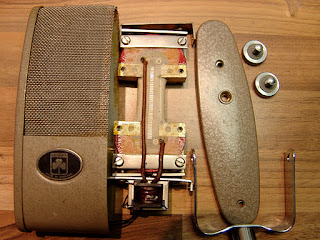It has been a long time since my last blog post!
This is mainly because the launch of Extinct Audio took up much more of my time and energy than I had ever imagined. But I have missed this blog and will be posting a bit more often in the coming weeks and months. Thanks for your support.
 |
| Lustraphone VR53 ribbon microphone |
This week I have been working on a few Lustraphone VR53 ribbon microphones. I have never been very enthusiastic about these mics because generally they have a weak output and can sound dark and flabby. Replacing the ribbons and transformers will get the mic so far, but they never quite get up to the performance of other British ribbon mics like the Reslos and Grampians. Which is a shame because they have a unique vintage design and look as though they should be good!
Part of the problem is the magnetic circuit. The two horseshoe magnets provide the field which is conducted (rather inefficiently) around a steel structure to the ribbon. This gives a field around 1500 to 2000 gauss. (For comparison, the field in a healthy Reslo would typically be around 4000 gauss.)
 |
| Milling the pole pieces to make room for new magnets. |
The steel pole structure is the limiting factor here and so swapping the horseshoe magnets gives only marginal improvements. For this upgrade I made a decision to mill out the pole pieces and fit some strong magnets right next to the ribbon.
The difference is impressive, bringing the field across the ribbon to 6000 gauss, which should provide about +9 to +12dB increase in output voltage. With a new ribbon fitted. the output and signal to noise were improved overall by 20dB. Now it can give the other microphones a good run for their money.
 |
| Before and after… new magnets and ribbons. |
As an aside, the stock 200 ohm transformer in this example is actually pretty good and don’t need to be replaced. The 30 ohm and high impedance models are not very well suited to a modern studio and in those cases it is worth swapping them out for a more sensible tranny.
You can read my earlier post about the Lustraphone VR53 microphones here.







